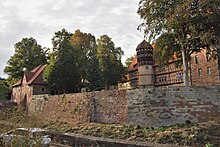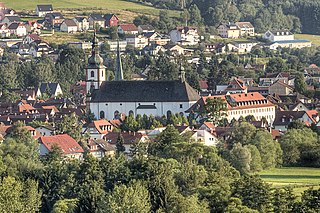
Bad Soden-Salmünster is a town in the Main-Kinzig district, in Hesse, Germany. It is situated on the river Kinzig, between Fulda and Hanau. It has a population of around 13,000.
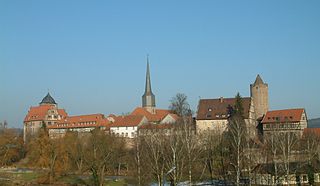
Schlitz is a small town in the Vogelsbergkreis in eastern Hesse, Germany.

Wachenbuchen is the smallest district in the city of Maintal, Hesse, Germany. It is about 17 km east of Frankfurt am Main.

Eiterfeld is a municipality in the district of Fulda, in Hesse, Germany. It is situated in the north of the district, 25 km north of Fulda.

Schloss Buchenau located in Buchenau between Fulda and Bad Hersfeld in the district of Eiterfeld, federal state (Bundesland) of Hesse, Germany.
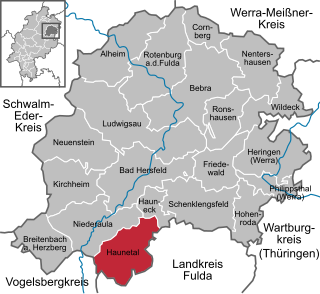
Haunetal is a community in Hersfeld-Rotenburg district in eastern Hesse, Germany. Haunetal is the district's southernmost municipality.

Jossgrund is a municipality in the Main-Kinzig district, in Hesse, Germany. It has around 3,500 inhabitants distributed among several formerly independent villages, now Ortsteile. The administration seat is at Oberndorf.

Schloss Heiligenberg is a castle to the east of Jugenheim, part of Seeheim-Jugenheim, about 12 kilometres to the south of Darmstadt, Germany. It is built on the Heiligenberg, with panoramic views of the Rhineland as far as the Palatinate. It is now the headquarters of the Amt für Lehrerbildung, though its 'Gartensaal' is occasionally used for concerts and art exhibitions.

Jestädt is a borough of the Municipality of Meinhard in the Werra-Meißner-Kreis in the State of Hesse of Germany.
The Fulda-Werra Uplands are a major natural regional unit in the East Hesse Highlands in East and North Hesse and, with small elements in the southeast, in the German state of Thuringia. Most of the range lies right of the River Fulda and left of the Werra. The uplands extend from the Rhön mountains northwards, to the River Weser near Hann. Münden.
The Brabant Road, Cologne to Leipzig Road or Liege Road is an ancient road which, during the Middle Ages and Early Modern Period, was one of the most important continental east-west oriented military and trade routes. It ran from the eponymous Duchy of Brabant to Leipzig.
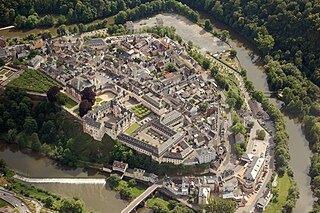
Schloss Weilburg is a Baroque schloss in Weilburg, Hesse, Germany. It is located on a spur above the river Lahn and occupies about half of the area of the Old Town of Weilburg. It contains the Hochschloss, built between 1530 and 1572, which is one of the best-preserved Renaissance palaces in Hesse. In the 1700s, the palace was expanded by John Ernst, Count of Nassau-Weilburg, and his builder, Julius Ludwig Rothweil. The buildings and gardens now belong to the Verwaltung der Staatlichen Schlösser und Gärten Hessen, and they can be visited as a museum on guided tours. Parts of the palace are venues for the music festival Weilburger Schlosskonzerte, which is named after the palace.

Auersburg Castle is a ruined hill castle in parish of Hilders in the county of Fulda in Hesse, Germany. The site is used today as a shelter and viewing platform.

Ebersburg Castle is a ruined hill castle in Ebersberg in the parish of Ebersburg in the county of Fulda in East Hesse, Germany. It is the symbol of Ebersberg as well as the origin of its name.

Haselstein Castle is a ruined hill castle near the village of Haselstein in Nüsttal in the county of Fulda in Hesse, Germany. It lies next to the village on a steep basalt cone at a height of 434 m above sea level (NN). The rock was first mentioned in 780/781 as the Haselahastein.

Jagdschloss Kranichstein is a palace in Kranichstein, now part of Darmstadt, Hesse, Germany. It was built north of Darmstadt from 1578 as a Jagdschloss, a hunting lodge for George I, Landgrave of Hesse-Darmstadt. It served also as a summer residence. In 1917, it became a museum of hunting. From 1946, it was the first location of the Darmstädter Ferienkurse.

Count Karl von Schlitz, in full: Karl Heinrich Wilhelm Hermann Ferdinand von Schlitz, genannt von Görtz was a German politician and Standesherr in the Grand Duchy of Hesse.

Worfelden is a village in the municipality of Büttelborn, which is located in the triangle formed by the cities of Frankfurt, Mainz and Darmstadt, within the Rhine-Main region.
Georg Herber was a child of The Enlightenment and jurist who entered government service, becoming a politician in his late middle age. He came to prominence in the Duchy of Nassau as a member of the duchy's "estates" . Though small in terms of territory, the duchy was not without influence in Germany due, in part, to the status of its ruler as a senior archbishop and as a prince-elector of the empire. Herber sat as a member of the lower house between 1818 and 1832, during most of which period he served, between 1819 and 1832, as president of the chamber.
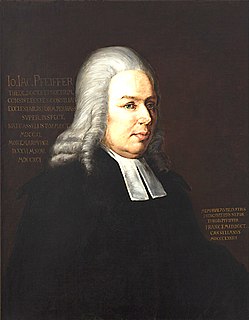
Johann Jakob Pfeiffer was a German evangelical theologian who taught at the University of Marburg.








